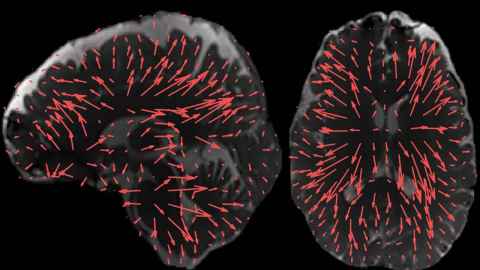Brain's tiny pulsations revealed in 'stunning' 3D images
6 May 2021
A breakthrough imaging technique could help researchers and doctors to understand and treat brain disorders.
Magnetic resonance imaging (MRI) images are usually meant to be static.
But now, scientists from Mātai Medical Research Institute in Gisborne, Stevens Institute of Technology, Stanford University, and the University of Auckland have published research on an imaging technique that captures the brain in motion in real time, in 3D and in fine detail.
The method provides a potential tool for detecting difficult-to-spot conditions such as obstructive brain disorders and aneurysms, before they become life threatening.
The technique, called 3D amplified MRI, or 3D aMRI, reveals pulsating brain movement which could help researchers visualise brain disorders and aid treatments for tiny deformations or disorders that obstruct the brain or block brain fluids.
Dr Samantha Holdsworth is the director of research at Mātai, a senior lecturer at the University of Auckland and a principal investigator at the university's Centre for Brain Research. She and Mehmet Kurt, an assistant professor of mechanical engineering at Stevens Institute of Technology in the US, have published two papers on aMRI in collaboration with Stanford University, the University of San Diego California, Queens University, and the Icahn School of Medicine at Mount Sinai.

The first paper, published in Magnetic Resonance in Medicine, presents the 3D aMRI method, comparing it with its 2D aMRI predecessor. The new method results in a visualisation of the human brain’s movement that can be seen in all directions.
The second paper, published in Brain Multiphysics, visualises, validates and quantifies exactly how the brain moves in three-dimensional space.
The approaches reported in the two papers could yield important clinical insights for brain disorders. For example, the abnormal motion of two areas at the base of the brain, the pons and cerebellum, could indicate Chiari I malformation, an abnormality that causes brain tissue to extend into the spinal canal.
Magnified microscopic rhythmic pulsations of the brain allow the visualisation of minute piston-like movements.
2D amplified MRI was developed by Dr Holdsworth, Mahdi Salmani Rahimi, Itamar Terem and other collaborators at Stanford University, enabling MRI imaging to capture brain motion in a way that had previously never been seen before. 3D amplified MRI builds on this previous work published in 2016.
The aMRI algorithm uses a video motion processing method developed by scientists at the Massachusetts Institute of Technology.
“The new method magnifies microscopic rhythmic pulsations of the brain as the heart beats to allow the visualisation of minute piston-like movements, that are less than the width of a human hair,” explains Itamar Terem, a graduate student at Stanford and lead author of the first paper.
“The new 3D version provides a larger magnification factor, which gives us better visibility of brain motion, and better accuracy.”
3D aMRI shows minute movements of the brain at an unprecedented spatial resolution, approximately the width of a human hair. Researchers say the images are “stunning".
The actual movements are amplified by up to 25 times. The striking detail of these animated magnified movements may be able to help identify abnormalities, such as those caused by blockages of spinal fluids.

A number of research projects are underway using the new imaging software. “We are using 3D aMRI to see if we can find new insights into the effect of mild traumatic brain injury on the brain,” says Holdsworth.
One study, a collaboration between Mātai and the University of Auckland, uses 3D aMRI and brain modelling methods to measure brain pressure without brain surgery. This could help in treating children with intracranial hypertension.
In the future, the technology could be used in connection with health disorders throughout the body.
Miriam Sadeng, an associate professor at the University of Auckland and an author on both papers says: “This fascinating new visualisation method could help us understand what drives the flow of fluid in and around the brain. It will allow us to develop new models of how the brain functions, that will guide us in how to maintain brain health and restore it in disease or disorder.”
In the future, the technology could be expanded for use in other health disorders throughout the body.
Media contact
Paul Panckhurst | Media adviser
M: 022 032 8475
E: paul.panckhurst@auckland.ac.nz